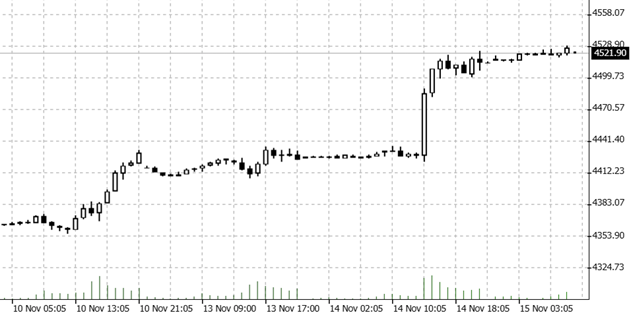

15.11.2023 – The year-end rally is probably underway. Yesterday’s US figures on consumer prices could have been the initial spark.
Of course, we can only answer the question of all questions with absolute certainty in retrospect. Will the year-end rally that is always reliably predicted materialise or not? If we look at the reaction on Wall Street yesterday, it speaks volumes: the bulls want to invest. The S&P 500 rallied when the news with the Consumer Price Index hit the tickers, here is the hourly chart. The Russell 2000 with shares of smaller companies recorded the strongest rise this year at over 5 per cent. US bonds were in demand again.

Source: Bernstein Bank GmbH
This is what happened: CPI for October was reported cooler than expected. Thus, the monthly comparison was unchanged; most expectations had been for an increase of 0.1 per cent. In September, the increase had still been 0.4 per cent. Year-on-year, the inflation rate slipped from 3.7 per cent to 3.2 per cent – analysts had predicted 3.3 per cent.
Short squeeze
As you can see, even a slight undercutting of the forecasts caused a small buying frenzy. A lot of investment pressure has obviously built up. We also saw a short squeeze. The financial blog “ZeroHedge” said that a lot of hedge funds had been caught on the wrong foot. Even super bear Michael Burry, who became a billionaire with his big short during the financial crisis in 2008, was wrong recently, realised a massive loss and ultimately liquidated many positions.
Brake for the Fed
The take-home message from all of this is that the Federal Reserve now has far fewer arguments for raising interest rates further or even keeping them higher. According to the website Barchart.com, the market currently sees the probability of a new interest rate hike on 12 December and 30 January at zero per cent. In addition, investors are 90 per cent certain that the Fed will cut interest rates again from 30 April 2024.
Nick Timiraos, Chief Economics Correspondent for the Wall Street Journal, commented that the Fed’s last rate hike for the time being was in July. The journalist is regarded as the unofficial mouthpiece of the Fed, which uses this channel to prepare the market for what is to come. Timiraos continued: “The big discussion within the Fed at the next meeting will only centre on how the fact that the central bank is de facto on hold should be communicated.
Winning stocks wanted
Our conclusion: As is so often the case, a lot of capital from previously sceptical fund managers is likely to flow into the equity market at the end of the year. They will buy those shares that have already performed well anyway – no asset manager wants to be asked by their clients why they were not invested in the top stocks. It’s called window dressing – the best stocks are displayed in the shop window. And the best shares are in the major indices. So: bull market ahead.
Of course, it is quite possible that the bull run will be disrupted by external factors. An escalation in Ukraine or a big bang in the Middle East would encourage the bears again. So far, however, the conflict remains confined to Gaza, where the Israeli army is smoking out the Arab Waffen SS hideouts under hospitals, kindergartens and schools. Hezbollah and Iran are keeping a low profile so far. Nevertheless, you should of course keep an eye on the real-time news. Whether long or short – Bernstein Bank wishes you successful trades and investments!
_________________________________________________________________________________________________________________________________
The content of this publication is for general information purposes only. In this context, it is neither an individual investment recommendation or advice nor an offer to purchase or sell securities or other financial products. The content in question and all the information contained therein do not in any way replace individual investor- or investment-oriented advice. No reliable forecast or indication for the future is possible with respect to any presentation or information on the present or past performance of the relevant underlying assets. All information and data presented in this publication are based on reliable sources. However, Bernstein Bank does not guarantee that the information and data contained in this publication is up-to-date, correct and complete. Securities traded on the financial markets are subject to price fluctuations. A contract for difference (CFD) is also a financial instrument with leverage effect. Against this backdrop, CFD trading involves a high risk up to the point of total loss and may not be suitable for all investors. Therefore, make sure that you have fully understood all the correlating risks. If necessary, ask for independent advice. CFDs are complex instruments and are associated with the high risk of losing money quickly because of the leverage effect. 68% of retail investor accounts lose money trading CFD with this provider. You should consider whether you understand how CFD work and whether you can afford to take the high risk of losing your money.7
